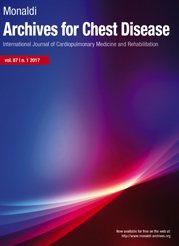Clinico-etiological profile and treatment outcome of hospitalized diffuse parenchymal lung disease patients: a prospective cohort study
All claims expressed in this article are solely those of the authors and do not necessarily represent those of their affiliated organizations, or those of the publisher, the editors and the reviewers. Any product that may be evaluated in this article or claim that may be made by its manufacturer is not guaranteed or endorsed by the publisher.
Authors
Diffuse parenchymal lung disease (DPLD) is a group of more than 200 pulmonary diseases that affect the alveoli, pulmonary interstitium, and/or small airways. DPLD patients often present in the outpatient department and inpatient department with acute/subacute worsening in their symptoms. These worsenings are due to a variety of causes that include acute exacerbations (AE), bacterial/viral/fungal infections, pneumothorax, pulmonary thromboembolism, or cardiac compromise. However, regardless of the type of underlying DPLD and the etiology of acute worsening when AE develops, it poses serious difficulties for patients, families, doctors, and the medical system. The current study was performed to evaluate the clinical presentation, etiological factors, and hospital course of DPLD patients presenting with acute/subacute worsening in their respiratory symptoms. A total of 39 hospitalized DPLD patients were recruited as per the inclusion and exclusion criteria. On admission, all relevant investigations were done, and the patients were evaluated thoroughly. All these patients were managed as per standard guidelines with regular monitoring. Based on the clinical course, treatment outcome was categorized as improved (discharged from hospital) or shifted to intensive care unit/mechanical ventilation and improved or died. The mean age of the study subjects was 57.95±11.7 years. The most common symptom reported in the study was dyspnea, followed by cough and fever. The most common etiology observed in the study, leading to hospital admission in DPLD patients, was respiratory infections and AE, followed by cardiac diseases. Out of the total 39 hospitalized DPLD patients, 13 patients required invasive mechanical ventilation, whereas 26 patients (66.7%) were managed with oxygen support/non-invasive ventilation/high-flow nasal oxygen. The univariate logistic analysis showed that patients with diabetes, pedal edema, idiopathic pulmonary fibrosis, regional wall motion abnormalities, and cardiac causes of acute clinical worsening were significant risk factors for the need for mechanical ventilation. On performing multivariate regression, none of the variables was an independent significant risk factor of mechanical ventilation. It is recommended to actively undertake monitoring and treating DPLD in conjunction with managing various concomitant illnesses, which is vital for improving outcomes and lowering the risk of acute clinical worsening and respiratory compromise.
Ethics Approval
The study protocol was approved by the Ethical Review Committee of GMCH -32 Chandigarh. (No./GMCH/IEC/775R/2022/166).How to Cite

This work is licensed under a Creative Commons Attribution-NonCommercial 4.0 International License.






